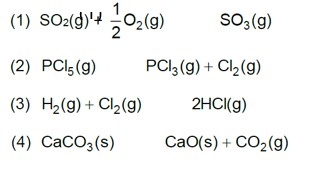7.21 Equilibrium constant, Kc for the reaction
N2 (g) + 3H2 (g) ⇌ 2NH3 (g) at 500 Kc is 0.061
At a particular time, the analysis shows that composition of the reaction mixture is 3.0 mol L–1 N2, 2.0 mol L–1 H2 and 0.5 mol L–1 NH3. Is the reaction at equilibrium? If not in which direction does the reaction tend to proceed to reach equilibrium?
7.21 Equilibrium constant, Kc for the reaction
N2 (g) + 3H2 (g) ⇌ 2NH3 (g) at 500 Kc is 0.061
At a particular time, the analysis shows that composition of the reaction mixture is 3.0 mol L–1 N2, 2.0 mol L–1 H2 and 0.5 mol L–1 NH3. Is the reaction at equilibrium? If not in which direction does the reaction tend to proceed to reach equilibrium?
-
1 Answer
-
According to available data:
N2 = [3.0], H2 = [2.0], NH3 = [0.50]
Qc = [NH3]2 / [N2] [ H2]3
= [0.50]2 / [3.0] [ 2.0]3
= 0.25/24
= 0.0104.
Since the value of Qc is less than that of Kc (0.061), the reaction is not in a state of equilibrium. It will proceed in the forward direction till Qc becomes the same as Kc.
Similar Questions for you
0.01 M NaOH,
M = 1 * 10-2

pOH = 2
pH = 2
Kp = Kc (RT)Dng
36 * 10–2 = Kc (0.0821 * 300)–1
Kc = 0.36 * 0.0821 * 300 = 8.86 » 9
A(g) ->B(g) + (g)
Initial moles n 0 0
Eqb. moles n(1 – a) na
total moles =
Eqb. pressure
On increasing pressure, equilibrium moves in that direction where number of gaseous moles decreases.
Taking an Exam? Selecting a College?
Get authentic answers from experts, students and alumni that you won't find anywhere else
Sign Up on ShikshaOn Shiksha, get access to
- 65k Colleges
- 1.2k Exams
- 679k Reviews
- 1800k Answers


